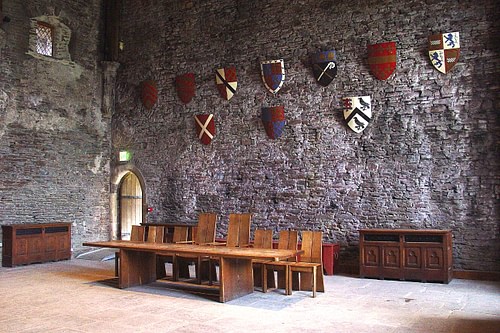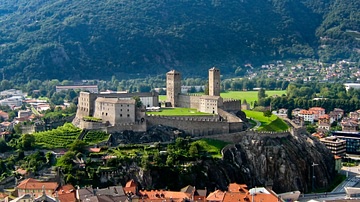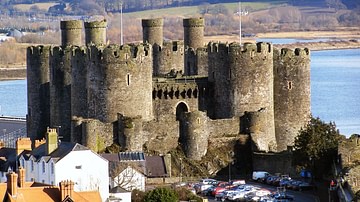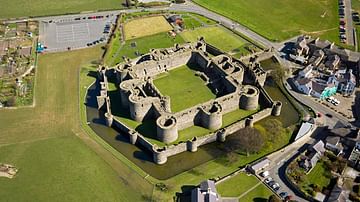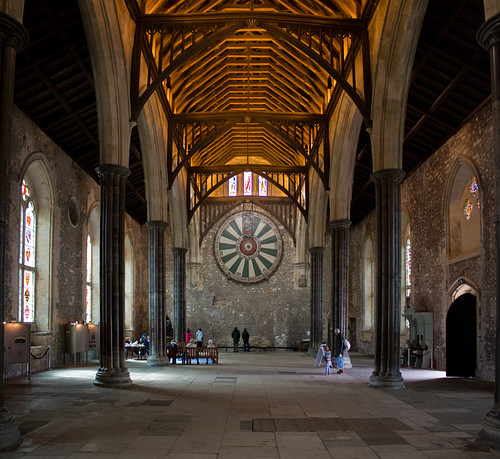
The Great Hall was the architectural centrepiece of a medieval castle's interior and functioned as the social and administrative hub of the castle and its estates. With everyone dining and sleeping in the hall in its early days, the room evolved to become the imposing host of banquets and courts. Beautifully decorated, well-lit and the largest indoor space most people would ever witness, the Great Hall was the perfect means for a noble to display both their power and generosity to the rest of local society.
Location
The first halls in the Early Medieval Period, as used by the Anglo-Saxons and Normans, for example, were large all-purpose buildings used by everyone, but with the arrival of the castle in the 11th century CE - first the motte and bailey with a simple tower keep and then the more expansive stone castles - an emphasis on security and social standing meant that impressive halls developed as part of larger buildings. Most early Great Halls were located in the safest part of the castle on the first floor (above the windowless ground floor) of a castle's tower keep, but they might also occupy a floor within a lower building in the castle's bailey or courtyard. The Great Hall remained remarkably unchanged throughout the Middle Ages and displayed the following key features:
- a rectangular form
- an impressive high and decorative ceiling
- many large windows
- a raised platform at one end
- a large centrally-placed hearth or fireplace.
Purpose
The primary function of a Great Hall was as a place to hold official audiences, to host the court which decided local legal matters, and to provide an elegant setting for banquets, but the room's wider importance to medieval society at large is here summarised by the historian C. Phillips:
Like the castle as a whole, the Great Hall was a bold statement of feudal power. Its size and architectural features - including the number of windows and the intricacy and profusion of decorative embellishments - embodied the lord's wealth and importance. (129)
The early Great Halls were not only a symbolic centre of the community but also a very real one as all the castle residents ate and slept in it. Even the castle lord and lady slept in the hall behind a curtain at one end. Sometimes the lord and his family slept in the gallery of the hall's second floor, from where they could also spy on the guests below through concealed 'squint' holes disguised in artworks. From the 12th century CE, as castles grew in size and accommodation became available elsewhere, the castle's owners had their own entirely separate chambers while the staff slept in the cellar and attic spaces.
The lord's supposed superiority to everyone else who visited the Great Hall was reinforced by the presence of his coats of arms on the walls, the liveried servants who wore his badge and the presence of a group of trumpeters blasting out from an upper gallery. Thus the hall became a suitable environment for such ceremonies as knighting a loyal retainer, dispensing the right to wear the lord's badge to a man-at-arms, granting the inheritance of land to a tenant knight, or giving out gifts to the lower classes.
Design & Layout
The dimensions of the Great Hall very much depended on the size of the castle, and these came in all sizes, of course. An early but typical example, now in ruins, is the Great Hall of Chepstow Castle in Wales, built between 1067 and 1090 CE, which measured 30 x 12 metres (100 x 40 ft). Given the wide distance the ceiling had to span, it was not uncommon for early halls to have one or two rows of wooden posts or stone pillars to support it. Once carpenters and masons had discovered the advantages of a truss (triangular support) ceiling construction, the columns could be eliminated and the hall made to seem even more spacious. The windows in 11th and 12th century CE halls were rarely glazed so that at night they would be closed using wooden shutters and an iron bar.
When castle design changed from the 13th century CE and more defensive emphasis was put on the curtain walls than the tower keep, Great Halls were sometimes built as free-standing buildings in the bailey or courtyard, such as the new Great Hall at Chepstow Castle, completed in 1285 CE. Another development of the 13th century CE, at least for the richest castle owners, was to add glass to the windows, although this was of poor quality and had a green tinge. By the 14th century CE, most Great Halls had glass in their windows. In contrast, the interiors of halls changed little and designs were so consistently followed that 400 years after their first appearance, Great Halls were still of very similar layout and proportions. The version of the Great Hall of Durham Castle in the 15th century CE, for example, was 30 x 14 m (100 x 46 ft).
Designed, then, to impress, the Great Hall usually had a beautiful wooden beam ceiling or impressive stone vaults, decorative stonework, and large windows (opening to the safe interior side of the castle) which gave plenty of light. The presence of light was itself an impressive feature in medieval times, and it was made the most of by adding seats to the windows. Wall decorations might include weapons, wall hangings (useful for keeping out drafts besides their aesthetic purpose), and plaster walls which might be decorated with red lines to imitate ashlar stonework or carry murals of daily life such as hunting and gardens or scenes of chivalry such as episodes from the legends of King Arthur.
The flooring was usually of beaten earth, stone or plaster, when on the ground floor, and, if on an upper floor, made using timber which might then be tiled. Curiously, despite the use of textiles for wall-hangings and benches, carpets were not common in northern European halls until the 14th century CE. Floors were usually covered with rushes and sprinkled with a good dose of herbs and flowers to improve the smell of the hall and deter vermin. These plants included basil, chamomile, lavender, mint, roses, and violets.
A large hearth in the centre of the room was a persistent feature of ground floor Great Halls, despite the obvious problem of the smoke they created. The hearth usually took a square, circular, or octagonal form and was edged with stones or tiles. A clay cover was put over the hearth at night to prevent any fire mishaps. In an effort to reduce the smoke accumulation, some architects added a flue to one or more of the windows. Other options included building ventilation holes through the roof covered by a terracotta figure or a louvre - a small structure like a lantern that could sometimes turn with the wind - which was opened or closed using a cord.
When Great Halls were built on the first floor, the hearth was moved up against a wall and given a stone hood to capture the smoke better. Smoke was driven out through a hole in the wall, usually through an outside supporting buttress. Eventually, by the start of the 13th century CE a fireplace with a chimney built into the wall had taken over as the best means to heat the room, but even a large one - some halls measured up to 18 metres (60 ft) in height - was usually not sufficient to heat all of the room. Later halls, therefore, often had several fireplaces. The Great Hall of Kenilworth Castle has a fireplace on each wall, including a huge triple fireplace at one end. Fireplaces increased in efficiency when it was discovered that using tiles at the back not only protected the stone from fire damage but helped to reflect the heat back into the room.
Rooms and corridors branched off from the hall and led to the kitchens, pantry, and private chambers. There might also be a wooden staircase along two walls which led up to private chambers on the next floor. The corridor which led off to the service rooms was usually concealed behind an ornate wooden screen and often lined with shelving. The main entrance to the hall was monitored by an usher who controlled who came and went, especially after the accessibility to the lord became a privilege in itself. This was again covered by a wooden screen with entrances at either side so that draughts were minimised. A gallery for musicians was often built above this screen.
Banquets
At dinner, long tables set on trestles with accompanying benches were set around the perimeter of the room. These were set up for mealtimes, but it did become a mark of prestige if there was space to keep one table permanently in the hall. The lord and lady of the castle with their immediate entourage usually sat on a raised platform of wood or stone at the end of the hall - the original high table and usually the most draught-free spot. Only the lord of the castle and sometimes his lady sat on a chair; everyone else had to make do with the benches. Seating arrangements were quite well defined. Laid with a tablecloth, each place had a knife, spoon, and cup while shared between diners were jugs for drinking and a dish for salt. Lighting was provided by rushlights, oil lamps made from bowls, flares or candles made from wax or tallow (animal fat). These lights could be set around the walls or on movable candelabra stands made of iron. The hall would have been decorated for special occasions like Christmas and religious feast days using local plants and flowers such as holly boughs and trailing ivy.
Decline & Legacy
By the end of the Middle Ages, as castles became less defensive fortresses and more private residences, their owners looked for a greater comfort and privacy than could be offered by the Great Hall. As one writer noted in the 14th century CE, lords and ladies were already abandoning the idea of eating in the Great Hall, at least on a regular basis:
Woe is in the hall each day in the week.
There the lord and lady like not to sit.
Now every rich man eats by himself
in a private chamber with a chimney
And leaves the great hall.
(Piers Plowman, William Langford, quoted in Gies, 74)
The castle owners preferred, instead, to take their meals in the small private chambers known as “withdrawing rooms”, away from the prying eyes, noise, and draughts of the Great Hall. For this reason, by the 17th century CE, the Great Halls had eventually evolved into the servants' hall of great houses. Great Halls, unfortunately, fell into disrepair along with their medieval castles, but some fine examples do still survive, perhaps the best being the 33.8 x 16.8 m Great Hall of Winchester Castle, built between 1222-35 CE.
The concept certainly survived even if most physical examples did not as the large communal hall had already taken root in other places. Large manor houses had copied the idea from castles, and many later buildings, keen to utilise the wow-factor of a grand room on visitors, also employed large open halls. The modern reincarnation of the Great Hall: the impressive entrance hall which branches off into smaller rooms, can still be seen today in such diverse buildings as imposing courthouses, national museums, and plush hotels.

